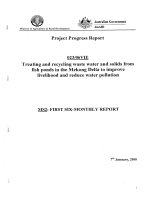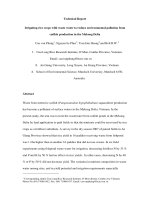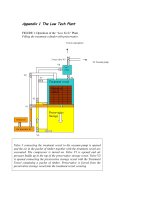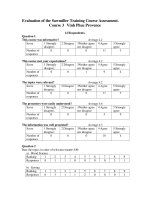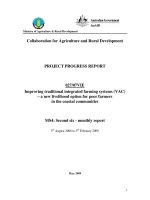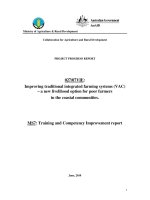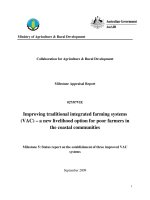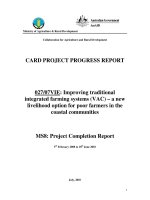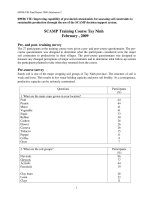Báo cáo khoa học nông nghiệp " The Low Tech Plant " potx
Bạn đang xem bản rút gọn của tài liệu. Xem và tải ngay bản đầy đủ của tài liệu tại đây (670.07 KB, 17 trang )
Appendix 1 The Low Tech Plant
FIGURE 1. Operation of the “Low Tech” Plant
Filling the treatment cylinder with preservative.
Vent to atmosphere
3 way valve V3
To Vacuum pump
V6
V8
V7 V4
V5
V1
V2.
Treatment vessel
Preservative
Storage
Packet of
timber
Vac
Chest
Compressor
Air
p
ressure in
Valve 3 connecting the treatment vessel to the vacuum pump is opened
and the air in the packet of timber together with the treatment vessel are
evacuated. The compressor is turned on. Valve V1 is opened and air
pressure builds up in the top of the preservative storage vessel. Valve V2
is opened connecting the preservative storage vessel with the Treatment
Vessel containing a packet of timber. Preservative is forced from the
preservative storage vessel into the treatment vessel covering
Emptying the treatment cylinder of preservative solution.
Vent to atmosphere
3 way valve V3
To Vacuum pump
V6
V8
V7 V4
V5
V1
V1
Treatment vessel
Preservative
Storage
Packet of
timber
Vac
Chest
Compressor
Air
p
ressure in
Once preservative solution (yellow) covers the timber, V4 and V1 are
closed. If it is desirable to apply pressure to the treated timber V8 is
opened. Once the desired pressure or holding time has been achieved V8 is
closed. V1, V5and V7 are now opened so that the pressures in the
preservative storage vessel and treatment vessel equalise. Whilst the
diagram illustrates that preservative enters the vacuum chest, normally
during flooding of the treatment vessel is terminated once the packet of
timber is covered with preservative solution. This is achieved by placing an
automatic sensor above the packet of timber to sense when the pack of
timber is covered. Preservative should now transfer by gravity back to the
storage vessel. Flow of preservative back to the treatment vessel can be
accelerated by opening V1 and V8. This pressurises the treatment cylinder.
Once all preservative has been transferred back to the storage vessel, all
valves should be shut and the treatment vessel door opened and the packet
of timber removed. No final vacuum is applied.
Appendix 3 Australian Hazard Classes based on Australian Standard AS 1604.
HAZARDNUMBER DECAY/INSECTHAZARD TYPICALCOMMODITIES
H1
LowDecayHazard(eg.Insect
Borer)
Timberframingnotexposedto
weather.
H2
Termites Timberframingintermite
infestedregions
H3
Abovegroundbutsubjectto
weathering
Fasciaboards,weatherboards,
externaljoinery,Glass‐house
components
H4
Groundcontact(lowvalue) Agriculturalposts,railway
sleepers
H5
Groundcontact(highvalue) TelegraphandElectricitypoles
H6
Exposedinseawater Marinepiles,boatbuilding
timberincontactwithsea‐
water
